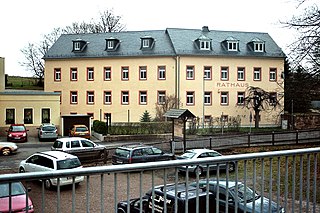
Stalag II-B was a German World War II prisoner-of-war camp situated 2.4 kilometres (1.5 mi) west of the town of Hammerstein, Pomerania on the north side of the railway line. It housed Polish, French, Belgian, Serbian, Dutch, Soviet, Italian and American prisoners of war.
Stalag Luft 7 was a World War II Luftwaffe prisoner-of-war camp located in Morzyczyn, Pomerania, and Bankau, Silesia. It held British, Canadian, Australian, New Zealander, French, Polish, South African, American and other Allied airmen.
Drzewice is the north-western borough (osiedle) of the town of Kostrzyn nad Odrą in western Poland.

Stalag III-A was a German World War II prisoner-of-war camp at Luckenwalde, Brandenburg, 52 kilometres (32 mi) south of Berlin. It housed Polish, Dutch, Belgian, French, Yugoslav, Russian, Italian, American, Romanian, British and other Allied POWs.

Stalag XI-B and Stalag XI-D / 357 were two German World War II prisoner-of-war camps (Stammlager) located just to the east of the town of Fallingbostel in Lower Saxony, in north-western Germany. The camps housed Polish, French, Belgian, Soviet, Italian, British, Yugoslav, American, Canadian, New Zealander and other Allied POWs.

Hartmannsdorf is a small municipality in the district Mittweida, Saxony, in eastern Germany, near the city of Chemnitz. As of 2020 it has a population of 4,421.

Stalag VIII-A was a German World War II prisoner-of-war camp, located just to the south of the town of Görlitz in Lower Silesia, east of the River Neisse. The location of the camp lies in today's Polish town of Zgorzelec, which lies over the river from Görlitz.

Hohnstein is a town located in the Sächsische Schweiz-Osterzgebirge district of Saxony, in eastern Germany. As of 2020, its population numbered a total of 3,262.

Stalag IV-B was one of the largest prisoner-of-war camps in Germany during World War II. Stalag is an abbreviation of the German Stammlager. It was located 8 km (5.0 mi) north-east of the town of Mühlberg in the Prussian Province of Saxony, just east of the Elbe river and about 30 mi (48 km) north of Dresden. From 1944 to 1945 it belonged to the Province of Halle-Merseburg. Now, the area is in Brandenburg. A sub-camp, sometimes identified as Stalag IV-B/Z,Stalag 304 or Stalag IV-H was located at Zeithain, 10 km (6.2 mi) to the south in Saxony.

Czarne is a town in Człuchów County of the Pomeranian Voivodeship in northern Poland. As of December 2022, the town has a population of 5,368.

Camp Fünfeichen was a World War II German prisoner-of-war camp located in Fünfeichen, a former estate within the city limits of Neubrandenburg, Mecklenburg, northern Germany. Built as Stalag II-A Neubrandenburg in 1939, it was extended by the officer camp Oflag II-E in 1940. After the Soviet takeover in 1945 until 1949 it was used as special camp, NKVD-camp Nr. 9 of the Soviet secret service (NKVD). Today, the site of the camp is a memorial.

Stalag IV-A Elsterhorst was a World War II German Army prisoner-of-war camp located south of the village of Elsterhorst, near Hoyerswerda in Saxony, 44 kilometres (27 mi) north-east of Dresden. It held Polish, French, Belgian, British, Serbian, Soviet, Dutch, Italian, American, Slovak, Czech, Bulgarian and other Allied POWs.

Oflag IV-D was a World War II German Army prisoner-of-war camp located in Elsterhorst near Hoyerswerda, then part of Lower Silesia, 44 km (27 mi) north-east of Dresden. It held mostly French, but also Belgian, Polish, Serbian, British and other Allied officers.

Macikai POW and GULAG Camps is the complex of prisoner-of-war camp and forced labor camps located near the village og Macikai (Matzicken) in German-occupied Lithuania and later, the Lithuanian SSR. The camp was opened and operated by Nazi Germany (1939–1944), and later became a Soviet prisoner-of-war camp No. 184 (1945–1948), finally transforming into a Soviet GULAG forced-labour camp (1945–1955).

The Gau March of Brandenburg was formed in March 1933 initially under the name Gau Electoral March in Nazi Germany as a district within the Free State of Prussia. In January 1939, Kurmark was renamed March of Brandenburg. The Gau was dissolved in 1945, following Allied Soviet occupation of the area and Germany's formal surrender. After the war, the territory of the former Gau became part of the state of Brandenburg in East Germany except for areas beyond the Oder-Neisse line, which were given to the Polish People's Republic. Most of its territory is now divided between Germany's State of Brandenburg and Poland's Lubusz Voivodeship.

Stalag XXI-D was a German World War II prisoner-of-war camp based in Poznań in German-occupied Poland, operated in 1940–1945. It held Polish, French, British, Belgian, Dutch, Serbian, Soviet and Italian POWs.

"Italian Military Internees" was the official name given by Germany to the Italian soldiers captured, rounded up and deported in the territories of Nazi Germany and German-occupied Europe in Operation Achse in the days immediately following the World War II armistice between Italy and Allied armed forces.

The Gau Pomerania formed on 22 March 1925, was an administrative division of Nazi Germany from 1933 to 1945 comprising the Prussian province of Pomerania. Before that, from 1925 to 1933, it was the regional subdivision of the Nazi Party in that area. Most of the Gau became part of Poland after the Second World War while the remainder became part of what would become East Germany.

Stalag 307 and Oflag 77 was a German prisoner-of-war camp operated during World War II in Dęblin in German-occupied Poland.
Stalag XXI-C was a German Army World War II prisoner-of-war camp located in Wolsztyn in German-occupied Poland. It held mostly Polish, French, British and Soviet POWs, but also American, Norwegian, Dutch and Italian.
















